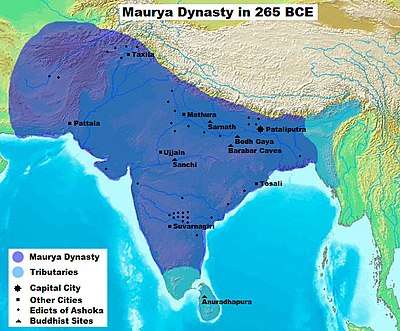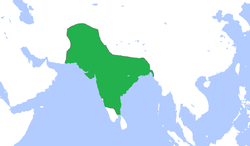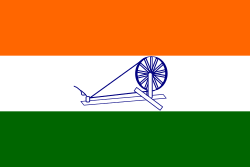Indian nationalism
Indian nationalism developed as a concept during the Indian independence movement fought against the colonial British Raj. Indian nationalism is an instance of territorial nationalism, inclusive of all its people, despite their diverse ethnic, linguistic and religious backgrounds. It continues to strongly influence the politics of India and reflects an opposition to the sectarian strands of Hindu nationalism and Muslim nationalism.[1][2][3][4]

| Part of a series on |
| Nationalism |
|---|
|
Core values |
|
|
Organizations |
|
Related concepts
|
|
National consciousness in India

India has been unified under many emperors and governments in history. Ancient texts mention India under emperor Bharata and Akhand Bharat, these regions roughly form the entities of modern-day greater India. The Mauryan Empire was the first to unite all of India, and South Asia (including much of Afghanistan).[5] In addition, much of India has also been unified under a central government by empires, such as the Gupta Empire, Rashtrakuta Empire, Pala Empire, Mughal Empire, Vijayanagara Empire, Maratha Empire, British Indian Empire, etc.
Conception of Pan-South Asianism
India's concept of nationhood is based not merely on territorial extent of its sovereignty. Nationalistic sentiments and expression encompass that India's ancient history,[6] as the birthplace of the Indus Valley Civilization and Vedic Civilization, as well as four major world religions – Hinduism, Buddhism, Jainism and Sikhism. Indian nationalists see India stretching along these lines across the Indian Subcontinent.
Ages of war and invasion


India today celebrates many kings and queens for combating foreign invasion and domination,[7] such as Shivaji of the Maratha Empire, Rani Laxmibai of Jhansi, Kittur Chennamma, Maharana Pratap of Rajputana, Prithviraj Chauhan and Tipu Sultan who fought the British. The kings of Ancient India, such as Chandragupta Maurya and Ashoka of the Magadha Empire, are also remembered for their military genius, notable conquests and remarkable religious tolerance.
Akbar was a Mughal emperor, was known to have a good relationship with the Roman Catholic Church as well as with his subjects – Hindus, Buddhists, Sikhs and Jains.[7] He forged familial and political bonds with Hindu Rajput kings. Although previous Sultans had been more or less tolerant, Akbar took religious intermingling to new level of exploration. He developed for the first time in Islamic India an environment of complete religious freedom. Akbar undid most forms of religious discrimination, and invited the participation of wise Hindu ministers and kings, and even religious scholars to debate in his court.
Colonial-era nationalism

The consolidation of the British East India Company's rule in the Indian subcontinent during the 18th century brought about socio-economic changes which led to the rise of an Indian middle class and steadily eroded pre-colonial socio-religious institutions and barriers.[8] The emerging economic and financial power of Indian business-owners and merchants and the professional class brought them increasingly into conflict with the British Raj. A rising political consciousness among the native Indian social elite (including lawyers, doctors, university graduates, government officials and similar groups) spawned an Indian identity[9][10] and fed a growing nationalist sentiment in India in the last decades of the nineteenth century.[11] The creation in 1885 of the Indian National Congress in India by the political reformer A.O. Hume intensified the process by providing an important platform from which demands could be made for political liberalisation, increased autonomy, and social reform.[12] The leaders of the Congress advocated dialogue and debate with the Raj administration to achieve their political goals. Distinct from these moderate voices (or loyalists) who did not preach or support violence was the nationalist movement, which grew particularly strong, radical and violent in Bengal and in Punjab. Notable but smaller movements also appeared in Maharashtra, Madras and other areas across the south.[12]
Swadeshi
The controversial 1905 partition of Bengal escalated the growing unrest, stimulating radical nationalist sentiments and becoming a driving force for Indian revolutionaries.[13]
The Gandhian era
Mohandas Gandhi pioneered the art of Satyagraha, typified with a strict adherence to ahimsa (non-violence), and civil disobedience. This permitted common individuals to engage the British in revolution, without employing violence or other distasteful means. Gandhi's equally strict adherence to democracy, religious and ethnic equality and brotherhood, as well as activist rejection of caste-based discrimination and untouchability united people across these demographic lines for the first time in India's history. The masses participated in India's independence struggle for the first time, and the membership of the Congress grew over tens of millions by the 1930s. In addition, Gandhi's victories in the Champaran and Kheda Satyagraha in 1918–19, gave confidence to a rising younger generation of Indian nationalists that the British Raj could be defeated. National leaders like Sardar Vallabhbhai Patel, Jawaharlal Nehru, Maulana Azad, Chakravarti Rajagopalachari, Mohandas Gandhi, Rajendra Prasad and Badshah Khan brought together generations of Indians across regions and demographics, and provided a strong leadership base giving the country political direction.
More than just "Indian"
Indian nationalism is as much a diverse blend of nationalistic sentiments as its people are ethnically and religiously diverse. Thus the most influential undercurrents are more than just Indian in nature. The most controversial and emotionally charged fibre in the fabric of Indian nationalism is religion. Religion forms a major, and in many cases, the central element of Indian life. Ethnic communities are diverse in terms of linguistics, social traditions and history across India.
Hindu Rashtra

An important influence upon Hindu consciousness arises from the time of Islamic empires in India. Entering the 20th century, Hindus formed over 75% of the population and thus unsurprisingly the backbone and platform of the nationalist movement. Modern Hindu thinking desired to unite Hindu society across the boundaries of caste, linguistic groups and ethnicity. In 1925, K.B. Hedgewar founded the Rashtriya Swayamsevak Sangh in Nagpur, Maharashtra, which grew into the largest civil organisation in the country, and the most potent, mainstream base of Hindu nationalism.[14]
Vinayak Damodar Savarkar coined the term Hindutva for his ideology that described India as a Hindu Rashtra, a Hindu nation. This ideology has become the cornerstone of the political and religious agendas of modern Hindu nationalist bodies like the Bharatiya Janata Party and the Vishwa Hindu Parishad. Hindutva political demands include revoking Article 370 of the Constitution that grants a special semi-autonomous status to the Muslim-majority state of Kashmir, adopting a uniform civil code, thus ending a special legal frameworks for different religions in the country.[15] These particular demands are based upon ending laws that Hindu nationalists consider to be special treatment offered to different religions.[16]
The Qaum
In 1906–1907, the All India Muslim League was founded, created due to the suspicion of Muslim intellectuals and religious leaders with the Indian National Congress, which was perceived as dominated by Hindu membership and opinions. However, Mahatma Gandhi's leadership attracted a wide array of Muslims to the independence struggle and the Congress Party. The Aligarh Muslim University and the Jamia Millia Islamia stand apart – the former helped form the Muslim league, while the JMI was founded to promote Muslim education and consciousness upon nationalistic and Gandhian values and thought.
While prominent Muslims like Allama Iqbal, Muhammad Ali Jinnah and Liaquat Ali Khan embraced the notion that Hindus and Muslims were distinct nations, other major leaders like Mukhtar Ahmed Ansari, Maulana Azad and most of Deobandi clerics strongly backed the leadership of Mahatma Gandhi and the Indian independence struggle, opposing any notion of Muslim nationalism and separatism. The Muslim school of Indian nationalism failed to attract Muslim masses and the Islamic nationalist Muslim League enjoyed extensive popular political support. State of Pakistan was ultimately formed following Partition of India
Views on the partition of India
Indian nationalists led by Mohandas K. Gandhi and Jawaharlal Nehru wanted to make what was then British India, as well as the 562 princely states under British paramountcy, into a single secular, democratic state.[17] The All India Azad Muslim Conference, which represented nationalist Muslims, gathered in Delhi in April 1940 to voice its support for an independent and united India.[18] The British, however, sidelined this nationalist Muslim organization and came to see Jinnah, who advocated separatism, as the sole representative of Indian Muslims.[19] To Indian nationalists, the British intentionally divided colonial India in order to keep the region weak.[20]
In an interview with Leonard Mosley, Nehru said that he and his fellow Congressmen were "tired" after the independence movement, so weren't ready to further drag on the matter for years with Jinnah's Muslim League, and that, anyway, they "expected that partition would be temporary, that Pakistan would come back to us."[21] Gandhi also thought that the Partition would be undone.[22] The All India Congress Committee, in a resolution adopted on 14 June 1947, openly stated that "geography and the mountains and the seas fashioned India as she is, and no human agency can change that shape or come in the way of its final destiny... at when present passions have subsided, India’s problems will be viewed in their proper perspective and the false doctrine of two nations will be discredited and discarded by all."[23] V.P. Menon, who had an important role in the transfer of power in 1947, quotes another major Congress politician, Abul Kalam Azad, who said that "the division is only of the map of the country and not in the hearts of the people, and I am sure it is going to be a short-lived partition."[24] Acharya Kripalani, President of the Congress during the days of Partition, stated that making India "a strong, happy, democratic and socialist state" would ensure that "such an India can win back the seceding children to its lap... for the freedom we have achieved cannot be complete without the unity of India."[25] Yet another leader of the Congress, Sarojini Naidu, said that she didn't consider India's flag to be India's because "India is divided" and that "this is merely a temporary geographical separation. There is no spirit of separation in the heart of India."[26]
Giving a more general assessment, Paul Brass says that "many speakers in the Constituent Assembly expressed the belief that the unity of India would be ultimately restored."[27]
Nationalism and politics
The political identity of the Indian National Congress, India's largest political party and one which controlled government for over 45 years, is reliant on the connection to Mohandas K. Gandhi and Jawaharlal Nehru, and the Nehru-Gandhi family which has controlled the Congress since independence. The Congress Party's fortunes up till the 1970s were single-handedly propelled by its legacy as the flagship of India's Independence Movement, and the core platform of the party today evokes that past strongly, considering itself to be the guardian of India's independence, democracy and unity.
Muslims had remained loyal voters of the Congress Party for a long time, as Congress party protected Muslim community's interests like banning The Satanic Verses of Salman Rushdie.[28] and allowing the unconstitutional practice of Triple Talaq to continue.[29][30] Recently, Muslims have started abandoning Congress party in favor of other parties like Aam Adami Party (AAP) and All India Majlis-e-Ittehadul Musilmeen (AIMIM). In contrast, the Bharatiya Janata Party employs a more aggressively nationalistic expression. The BJP seeks to preserve and spread the culture of the Hindus, the majority population. It ties nationalism with the defence of India's borders and interests against archrivals China and Pakistan, with the defence of the majority's right to be a majority.
Religious nationalist parties include the Shiromani Akali Dal, which is closely identified with the creation of a Sikh-majority state in Punjab and includes many Sikh religious leaders in its organisation. In Maharashtra, the Shiv Sena uses the legacy of the independent Maratha kingdom under famous figures like Shivaji to stir up support, and has adopted Hindutva as well. In Assam, the Asom Gana Parishad is a more state-focused party, arising after the frustration of the United Liberation Front of Asom (ULFA) as a benevolent expression of Assamese nationalism. In Tamil Nadu came the first of such parties, the Dravidar Kazhagam (DK). Today the DK stands for a collection of parties,[31] with the Dravida Munnetra Kazhagam (DMK), the All India Anna Dravida Munnetra Kazhagam (AIADMK), the Pattali Makkal Katchi (PMK) and the Marumalarchi Dravida Munnetra Kazhagam (MDMK). Caste-based politics invite the participation of the Bahujan Samaj Party and the party of Lalu Prasad Yadav, who build upon the support of poor low-caste and dalit Hindus in the northern, and most populated states of India like Uttar Pradesh and Bihar. Almost every Indian state has a regional party devoted solely to the culture of the native people of that state.
Nationalism and military conflicts

The modern Army of India was raised under the British Raj in the 19th century. Today the Republic of India maintains the world's third largest armed forces with over a million troops strong.[32] The official defence budget stands at ₹1,644,151.9 million (US$23 billion)[33] but the actual spending on the armed forces is estimated to be much higher.[34] The army is undergoing rapid expansion and modernisation[35] with plans to have an active military space program,[36] missile defence shield,[37] and nuclear triad capability.[38]
See also
- History of India
- Swadeshi movement
- Indian century
References
- Lerner, Hanna (12 May 2011), Making Constitutions in Deeply Divided Societies, Cambridge University Press, pp. 120–, ISBN 978-1-139-50292-4
- Jaffrelot, Christophe (1999), The Hindu Nationalist Movement and Indian Politics: 1925 to the 1990s : Strategies of Identity-building, Implantation and Mobilisation (with Special Reference to Central India), Penguin Books India, pp. 13–15, 83, ISBN 978-0-14-024602-5
- Pachuau, Lalsangkima; Stackhouse, Max L. (2007), News of Boundless Riches, ISPCK, pp. 149–150, ISBN 978-81-8458-013-6
- Leifer, Michael (2000), Asian Nationalism, Psychology Press, pp. 112–, ISBN 978-0-415-23284-5
- Afghanistan Country Study Guide Volume 1 Strategic Information and Developments geredigeerd door Inb, Inc. 10 September 2013. ISBN 9781438773728. Retrieved 27 February 2015.
- Acharya, Shiva. "Nation, Nationalism and Social Structure in Ancient India By Shiva Acharya". Sundeepbooks.com. Archived from the original on 15 February 2012. Retrieved 17 November 2011.
- "Mahrattas, Sikhs and Southern Sultans of India : Their Fight Against Foreign Power/edited by H.S. Bhatia". Vedamsbooks.com. Retrieved 17 November 2011.
- Mitra 2006, p. 63
- Croitt & Mjøset 2001, p. 158
- Desai 2005, p. xxxiii
- Desai 2005, p. 30
- Yadav 1992, p. 6
- Bose & Jalal 1998, p. 117
- "Rashtriya Swayamsevak Sangh | History, Ideology, & Facts". Encyclopedia Britannica. Retrieved 28 July 2020.
- "What is Uniform Civil Code?". Jagranjosh.com. 7 August 2019. Retrieved 28 July 2020.
- "WHAT IS UNIFORM CIVIL CODE". Business Standard India. Retrieved 28 July 2020.
- Hardgrave, Robert. "India: The Dilemmas of Diversity", Journal of Democracy, pp. 54–65
- Qasmi, Ali Usman; Robb, Megan Eaton (2017). Muslims against the Muslim League: Critiques of the Idea of Pakistan. Cambridge University Press. p. 2. ISBN 9781108621236.
- Qaiser, Rizwan (2005), "Towards United and Federate India: 1940-47", Maulana Abul Kalam Azad a study of his role in Indian Nationalist Movement 1919–47, Jawaharlal Nehru University/Shodhganga, Chapter 5, pp. 193, 198, hdl:10603/31090
- Yousaf, Nasim (31 August 2018). "Why Allama Mashriqi opposed the partition of India?". Global Village Space. Retrieved 24 January 2019.
- Sankar Ghose, Jawaharlal Nehru, a Biography, Allied Publishers (1993), pp. 160-161
- Raj Pruthi, Paradox of Partition: Partition of India and the British strategy, Sumit Enterprises (2008), p. 443
- Graham Chapman, The Geopolitics of South Asia: From Early Empires to the Nuclear Age, Ashgate Publishing (2012), p. 326
- V.P. Menon, The Transfer of Power in India, Orient Blackswan (1998), p. 385
- G. C. Kendadamath, J.B. Kripalani, a study of his political ideas, Ganga Kaveri Pub. House (1992), p. 59
- Constituent Assembly Debates: Official Report, Volume 4, Lok Sabha secretariat, 14 july 1947, p. 761
- Paul R. Brass, The Politics of India Since Independence, Cambridge University Press (1994), p. 10
- Rajiv Gandhi's ban of Satanic Verses was wrong says Minister
- Rajiv Gandhi continued the practice of triple talaq
- "Character of Nehruvian Secularism". Bharatvani.org. Archived from the original on 27 September 2011. Retrieved 17 November 2011.
- "Tamil Nadu / Madurai News : Vijaykanth slams Dravidian parties". The Hindu. 8 January 2009. Retrieved 17 November 2011.
- "A Thomson Reuters Foundation Service". AlertNet. Retrieved 17 November 2011.
- "Defence Budget 2011–12 – Misplaced Euphoria – India Defence – Security Trends South Asia – Security-Risks.com Caring for your Safety, Life & Security". Security-risks.com. 2 March 2011. Retrieved 17 November 2011.
- Business Standard (11 March 2008). "Ajai Shukla: How much is the defence budget?". Business-standard.com. Retrieved 17 November 2011.
- Greenlees, Donald (19 September 2007). "China and India leading Asian missile buildup – The New York Times". International Herald Tribune. Retrieved 17 November 2011.
- Gavin Rabinowitz, Associated Press (18 June 2008). "India's army seeks military space program". Sfgate.com. Retrieved 17 November 2011.
- India successfully tests missile interceptor
- TNN, 27 February 2008, 12:34 am IST (27 February 2008). "India test fires submarine-launched ballistic missile – India – The Times of India". Timesofindia.indiatimes.com. Retrieved 17 November 2011.CS1 maint: multiple names: authors list (link)
Bibliography
- Bose, Sugata; Jalal, Ayesha (1998), Modern South Asia: History, Culture, Political Economy, New York: Routledge, ISBN 0-415-16952-6
- Croitt, Raymond D; Mjøset, Lars (2001), When Histories Collide, Oxford, UK: AltaMira, ISBN 0-7591-0158-2
- Desai, A.R. (2005), Social Background Of Indian Nationalism (6Th-Edn), Popular Prakashan, ISBN 978-81-7154-667-1
- Mitra, Subrata K. (2006), The Puzzle of India's Governance: Culture, Context and Comparative Theory, Routledge, ISBN 978-1-134-27493-2
- Mukherjee, Bratindra Nath (2001), Nationhood and Statehood in India: A historical survey, Regency Publications, ISBN 978-81-87498-26-1
- Yadav, B.D (1992), M.P.T. Acharya, Reminiscences of an Indian Revolutionary, New Delhi: Anmol Publications Pvt ltd, ISBN 81-7041-470-9